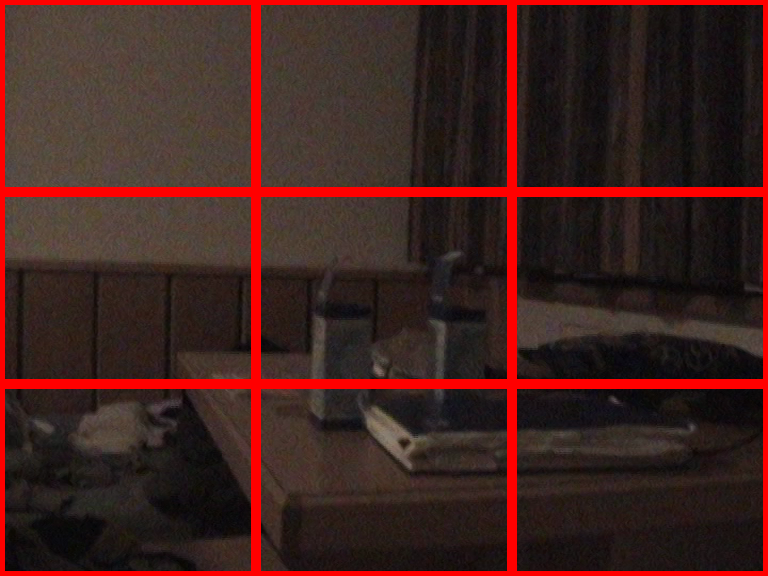Presets for FFV1 and MKV:
Choosing the right parameters for the job.
November 2019
FFV1 Video Codec
Parameters
- coder
- context
- slices
- slicecrc
- level
Coder
- 0 = Golomb Rice (Default 8bpc)
- 1 = Range Coder (Default > 8bpc)
(with default transition table) - 2 = Range Coder
(with custom transition table)
Context
- 0 = small (Default)
- 1 = large
Slices
- Image is divided into separate areas
- Used for parallel encoding
- Only with FFV1 version ≥ 2
- Each slice has its header
- But: More slices = slightly more space
(a few bytes/slice)
9 Slices

SliceCRC
- CRC = Cyclic Redundancy Check
- Checksum per slice
- More slices = more safety
- To know if a slice is okay.
- Decoders can choose:
“what to do if it’s not?”
Level = FFV1 version
- 0
- 1 (Default)
- 3 (Recommended)
Scan type
FFV1 can store field-order information independent of its container.
Scan type
aka “picture structure” (IETF specs)
- 0 = unknown
- 1 = top field first (TFF)
- 2 = bottom field first (BFF)
- 3 = progressive
- Other = reserved for future use
Default values
- level: 1 (!)
- coder:
- = 8bpc: 0 (golomb rice)
- > 8bpc: 1 (range)
- context = 0 (small)
- slices = 4
- slicecrc = 1
Matroska Container (MKV)
Some Parameters
- SegmentUID
- SeekHead
- Scan type
- Color information:
- Sample range
- Color primaries
- Transfer characteristics
- Matrix coefficients
SegmentUID
“A randomly generated unique ID to identify the Segment amongst many others (128 bits).”
SegmentUID
[Segment:] “The Root Element that contains all other Top-Level Elements (Elements defined only at Level 1). A Matroska file is composed of 1 Segment.”
SeekHead
“Contains the Segment Position of other Top-Level Elements.”
It can be used to uniquely identify this MKV file and is part of the “MetaSeek” section.
MetaSeek
“The Metaseek section contains an index of where all of the other groups are in the file are located […].”
“This element isn’t technicaly required, but you would have to search the entire file to find all of the other Level 1 elements if you did not have it.
This is because any of the items can occur in any order."
Fixity
CRC-32 per Element.
The magic’s inside EBML.
Scan type
FlagInterlaced
- 0 = undetermined
- 1 = interlaced
- 2 = progressive
FieldOrder
- 0 = progressive
- 1 = top field first (TFF)
- 2 = undetermined
- 6 = bottom field first (BFF)
- 9 = BFF (swapped)
- 14 = TFF (swapped)
Color information (MKV/FFmpeg)
- colour-range (full, broadcast)
-color_range mpeg - colour-primaries
-color_primaries bt470bg - colour-transfer-characteristics
-color_trc bt709 - colour-matrix-coefficients
-colorspace bt470bg
Source: “mkvpropedit -l”, vrecord
Tagging
aka “Descriptive Metadata”.
“[…] contains all of the Tags that relate to the the file and each of the tracks. These tags are just like the ID3 tags found in MP3’s.”
Attachments
“The Attachment section is for attaching any type of file you want to a Matroska file. You could attach anything, pictures, webpages, programs, even the codec needed to play back the file.”
FFmpeg recipe (PAL)
ffmpeg -i VIDEO_IN \
-c:v ffv1 -level 3 -coder 1 -context 0 -slices 24 -slicecrc 1 \
-color_primaries bt470bg \
-color_trc bt709 \
-colorspace bt470bg \
-color_range mpeg \
-map 0 \
-top 1 \
-c:a copy \
-g 1 -pix_fmt + \
VIDEO_OUT.mkvMXF-like profiles or presets
- Currently don’t exist.
- But might make sense to define some.
- Don’t overdo it.
- Works well without yet.